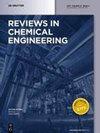氨基脲的缓蚀相关性:电子结构、反应性和配位化学
IF 4.9
3区 工程技术
Q1 ENGINEERING, CHEMICAL
引用次数: 10
摘要
摘要缩氨基脲(OC(NH2)(N2H3))和缩氨基硫脲(SC(NH2。它们含有杂原子(N、O和S)形式的非键电子,以及>C=O和>C=S形式的π-电子,因为它们与金属原子和离子强配位。由于氨基脲(SC)、硫代氨基脲(TSC)及其衍生物与这种性质有关,它们被广泛用于不同的应用。它们是合成各种工业和生物有用化学物质的基础。SC、TSC及其衍生物也可作为强水相缓蚀剂。综述了氨基脲(SC)、氨基硫脲(TSC)及其衍生物的配位能力和防腐性能。这些化合物被广泛用作不同金属和合金的抑制剂。它们通过富含电子的位置吸附在金属表面并形成防腐膜。它们的吸附主要遵循Langmuir吸附等温线。通过吸附,它们增加了电荷转移电阻值,降低了腐蚀电流密度值。文献中采用的计算研究表明,SC、TSC及其衍生物利用电荷转移机制平坦自发地吸附。本文章由计算机程序翻译,如有差异,请以英文原文为准。
Corrosion inhibition relevance of semicarbazides: electronic structure, reactivity and coordination chemistry
Abstract Semicarbazide (OC(NH2)(N2H3)) and thiosemicarbazide (SC(NH2)(N2H3)) are well-known for their coordination complex formation ability. They contain nonbonding electrons in the form of heteroatoms (N, O and S) and π-electrons in the form of >C=O and >C=S through they strongly coordinate with the metal atoms and ions. Because of their association with this property, the Semicarbazide (SC), thiosemicarbazide (TSC) and their derivatives are widely used for different applications. They serve as building blocks for synthesis of various industrially and biologically useful chemicals. The SC, TSC and they derivatives are also serve as strong aqueous phase corrosion inhibitors. In the present reports, the coordination ability and corrosion protection tendency of Semicarbazide (SC), thiosemicarbazide (TSC) and their derivatives is surveyed and described. These compounds are widely used as inhibitors for different metals and alloys. Through their electron rich sites they adsorb on the metal surface and build corrosion protective film. Their adsorption mostly followed the Langmuir adsorption isotherm. Through their adsorption they increase the value of charge transfer resistance and decrease the value of corrosion current density. Computational studies adopted in the literature indicate that SC, TSC and their derivatives adsorb flatly and spontaneously using charge transfer mechanism.
求助全文
通过发布文献求助,成功后即可免费获取论文全文。
去求助
来源期刊

Reviews in Chemical Engineering
工程技术-工程:化工
CiteScore
12.30
自引率
0.00%
发文量
37
审稿时长
6 months
期刊介绍:
Reviews in Chemical Engineering publishes authoritative review articles on all aspects of the broad field of chemical engineering and applied chemistry. Its aim is to develop new insights and understanding and to promote interest and research activity in chemical engineering, as well as the application of new developments in these areas. The bimonthly journal publishes peer-reviewed articles by leading chemical engineers, applied scientists and mathematicians. The broad interest today in solutions through chemistry to some of the world’s most challenging problems ensures that Reviews in Chemical Engineering will play a significant role in the growth of the field as a whole.
 求助内容:
求助内容: 应助结果提醒方式:
应助结果提醒方式:


